Prosocial Behavior & Interpersonal Relationships
1/122
Earn XP
Description and Tags
Name | Mastery | Learn | Test | Matching | Spaced |
|---|
No study sessions yet.
123 Terms
Empathy vs. Personal Distress Model
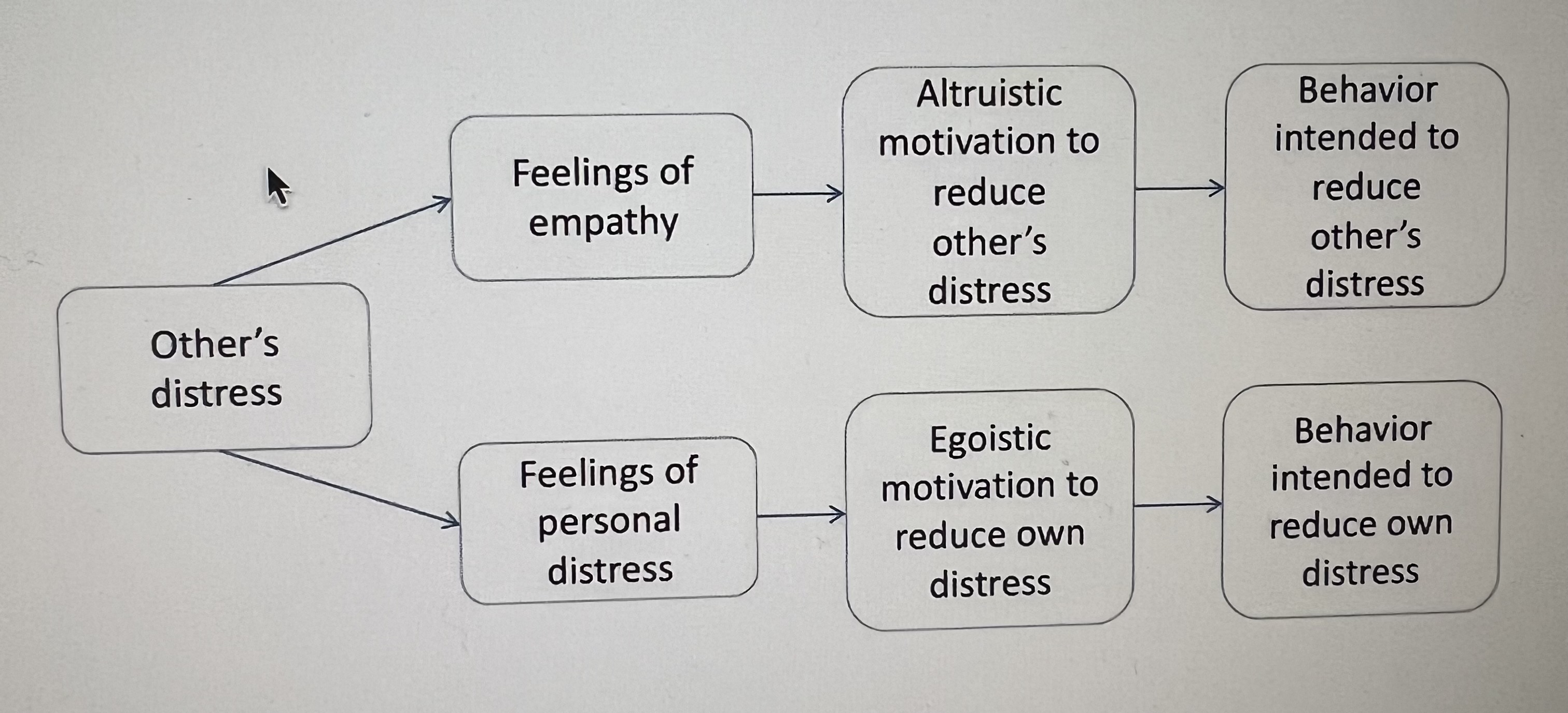
Empathy-Altruism Hypothesis
The proposition that empathetic concern for a person indeed produces an altruistic motive for helping
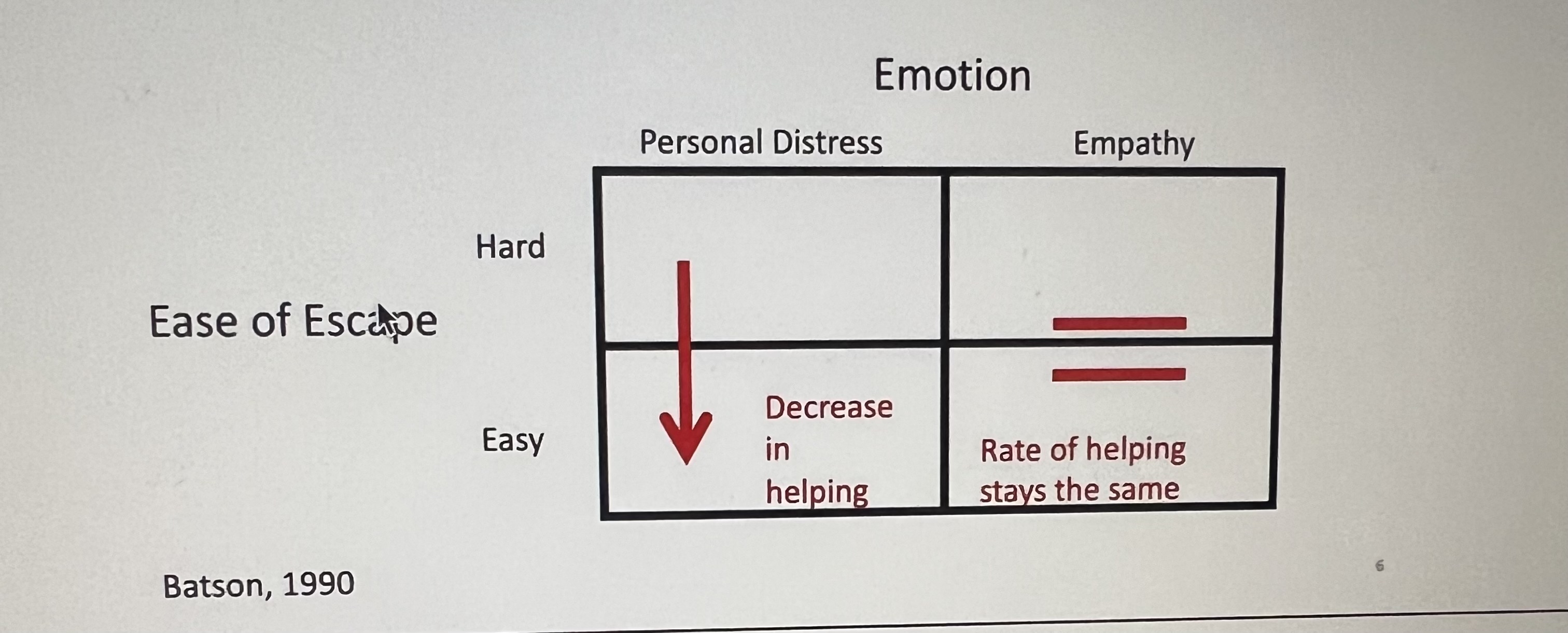
Motives for helping behavior -Altruism
selfless concern for the welfare of others, can be motivated by a variety of factors, including empathy a desire to reduce negative feelings, social rewards and a sense of interconnectedness
Empathy
The process by which observers come to understand and/or feel the state of another through direct perception of imagination of their state
Sympathy
Tenderhearted feelings of compassionate concern, feeling “sorry for” the other
Metalizing
Extracting and understanding another person’s goals by making inferences about his/her mind state
Mind Perception
How people perceive the mental state of others focusing on two key dimensions: Agency (the ability to think, plan and act) and experience (the ability to feel have sensations and be conscious)
Shared Attention
When two people focus on the same thing, whether it’s an object, an event, or another person, and acknowledge that they are sharing that focus
Perspective Thinking
Ability to understand and consider a situation from someone else’s pov
Mirroring/Experiencing Sharing
Simulating the state of the other understand the content of their mind. The rationale is that observing another person activated the corresponding motor and mental representations in the observer, enabling them to understand the other’s mind
Neural Synchrony
Observation of actions, emotion, experiences of pain, etc activated the same neural substrates that are active during the actual performance of the action, emotional experience, experience of pain, etc by the observer
The Empathy-Altruism Hypothesis- An Experiment (Method)
Participant and Confederate draw straws to determine who will receive electric shocks
Participant observed Confederate receiving shocks
Measure emotions (personal distress vs. empathy)
Opportunity to help: “Take some of the shocks?”
Escape manipulation: “you can watch tv,” “you have to watch the confederate”
The Empathy-Altruism Hypothesis - An experiment (results)
People who are feeling empathy still help, even when escape is easy
Neural Synchrony & Empathy
Synchrony is involved in action understanding, action coordination, observational learning, and empathy
Mental State Inference
Figuring out what another person thinks or wants, requires setting aside one’s own point of view
effects of biased empathy on helping
Empathy that is influenced by group membership-affects pro social behavior, particularly helping
Effects of biased empathy on helping - Experiment
Examined how people respond to the suffering of others depending on whether those others belong to their in group (e.g. same sports team) or out group (e.g. rival team)
Effects of biased empathy on helping - Experiment (Findings)
Ingroup Bias in Empathy: Participants felt more empathy for members of their ingroup. Neural responses in areas associated with empathy
Prediction of Helping Behavior: Biased neural empathy predicted actual costly helping behavior (e.g. enduring pain to reduce another’s pain)
Reduced Empathy for Outgroup: Weaker empathic to out group members correlated with reduced willingness to help them, even when their suffering was the same
Helping in Emergencies: 5 Stage Model
Noticing the Situation
Labeling the Situation as an Emergency
Assuming the Responsibility to Help: An Experiment
Deciding How to Help
Implementing the Decision to Help
Labeling the Situation as an Emergency
Less likely if the situation is ambiguous
Led likely if there are other people around who seem unconcerned
Assuming the Responsibility to Help: An Experiment (Method)
Group Discussion via intercom conditions: Talk to 1 other participant & talk to 5 other participants
One of the other “participants” points out a relevant health problem
Participant with health problem calls for help
Bystander Effect
Phenomenon that helping behavior is less likely to occur as the number of witnesses to an emergency increases
Effects of Bystander Effect
Diffusion of Responsibility & Pluralistic Ignorance
Diffusion of Responsibility
Explanation that suggests that each bystander assumes someone’s else will assume responsibility
Pluralistic Ignorance
Explanation that suggests that bystanders use other people’s reactions (or lack of reactions) as N indication that the victim doesn’t need help
Deciding How To Help
Decisions to help are more likely if people perceive themselves as competent and capable of helping
Implementing the Decision to Help
More likely if the costs of helping are low
More likely if the victim is perceived as deserving of help
Cost of Helping: Experiment (Method)
Participants read the parable of the Good Samaritan, then were asked to to a different building to give a talk. In what they had read
Participants were told 1 of 3 things: “It’ll be a few minutes”, “They’re ready for you”, “You’re late”
On their way to the next building, participants encouraged a person slumped in a doorway, head down, eyes closed not moving
In the Cost of Helping Experiment, how did the confederate scale their helpfulness
Failed to notice victims need
Perceived the victim as in need but did not offer aid
Did not stop but helped indirectly
Stopped and asked if victim needed help
After stopping, insisted on taking the victim inside
Cost of Helping Experiment Results
People with low hurry helped more than the people who high hurry. As well if one talked about good samaritanas than just seminarians
Attributions of Responsibility
Assigning blame or credit for an action or outcome, determining who is accountable for what happened

Attributions of Responsibility: perceptions of Controllability
If an event seems more controllable, people tend to attribute more responsibility
Example
Low: Can I borrow your notes? I have a vision problem
High: Can I borrow your notes? I was at the beach last class
Attributions of Responsibility (Schmidt & Weiner 1988)
Explored how people’s AOR for others’ misfortunes influence their emotional and helping responses. Grounded in Weiner’s attribution-emotion-action theory which connected to interpret causes of events
Attributions of Responsibility (Schmidt & Weiner 1988) Findings
Casual Attributions: People make judgements about the causes of someone’s suffering
Responsibly Judgements: If someone seems response for their misfortune (e.g. gambling addict that chooses to gamble), observers are less sympathetic
Emotional Responses: HR → anger or difference, LR → sympathy or compassion
Helping Behavior: Sympathy increases the likelihood of helping. Anger or blame reduced helping behavior
Attributions of Responsibility (Schmidt & Weiner 1988): Results
How we assign blame or responsibility directly impacts our willingness to help . The more we think someone “deserves” their situation the less likely we are to help
Belief in a Just World - Self
Believing I’m that the world is just for the self leads to greater life satisfaction
Belief in a Just world - Other
Believing that the world is just for others leads to harsher towards the p
Developing and Maintaining Friendships
Developing our friendship through 6 stages

Role Limited Interaction
Interact with others based on our social roles
Friendly Relations
Characterized by communication that moves beyond initial roles as the participants began to interact with one another to see if there are common interests, as well as an interest to continue getting to know one another
Moving Toward Friendship
Participants make moves to alter more personalized friendship
Nascent Friendship
Individuals commit to spend more time together
Stabilized Friendship
Friends take each other for granted as friends, but not in a negative way. Because the friendship is solid, they assume each other will be in their lives.
Waning Friendships
Sometimes friendships come to an end. Sometimes people change and grow into different directions
Challenges of Friendship
Gender: Women and men interact different within women’s and men’s friendships
Culture: Shape how we under our friendships
Misattribution of Arousal
Tendency for people to incorrect label the source of the arousal they are experiencing
Sternberg’s Triangular Theory of Love
Theory that proposed that there are three components of love: infancy, passion and commitment that define multiple types of love

Homophily
Tendency for people to form social networks, including friendships, marriages business relationships, and many other types of relationships with others who are similar
Reciprocity
The give and take in relationships
Stages of Relationships

No Interaction
Have not interacted yet
Invitational Communication
When we are attracted to someone, we may signal or invite them to interact with us
Explorational Communication
We share information about ourselves while looking for mutual interests, shared political or religious views, and similarities in family background
Intensifying Communication
Happy stage, where couples spend more time with the other person
Revising Communication
When the “relational high” begins to wear off, coupled being to have a more realistic perspective of one another and the relationship as a whole, here people may recognize the faults of the other person that they so idealized in the previous stage
Navigating
When couples continue to revise their communication and ways of interacting to reflect the changing needs of each person
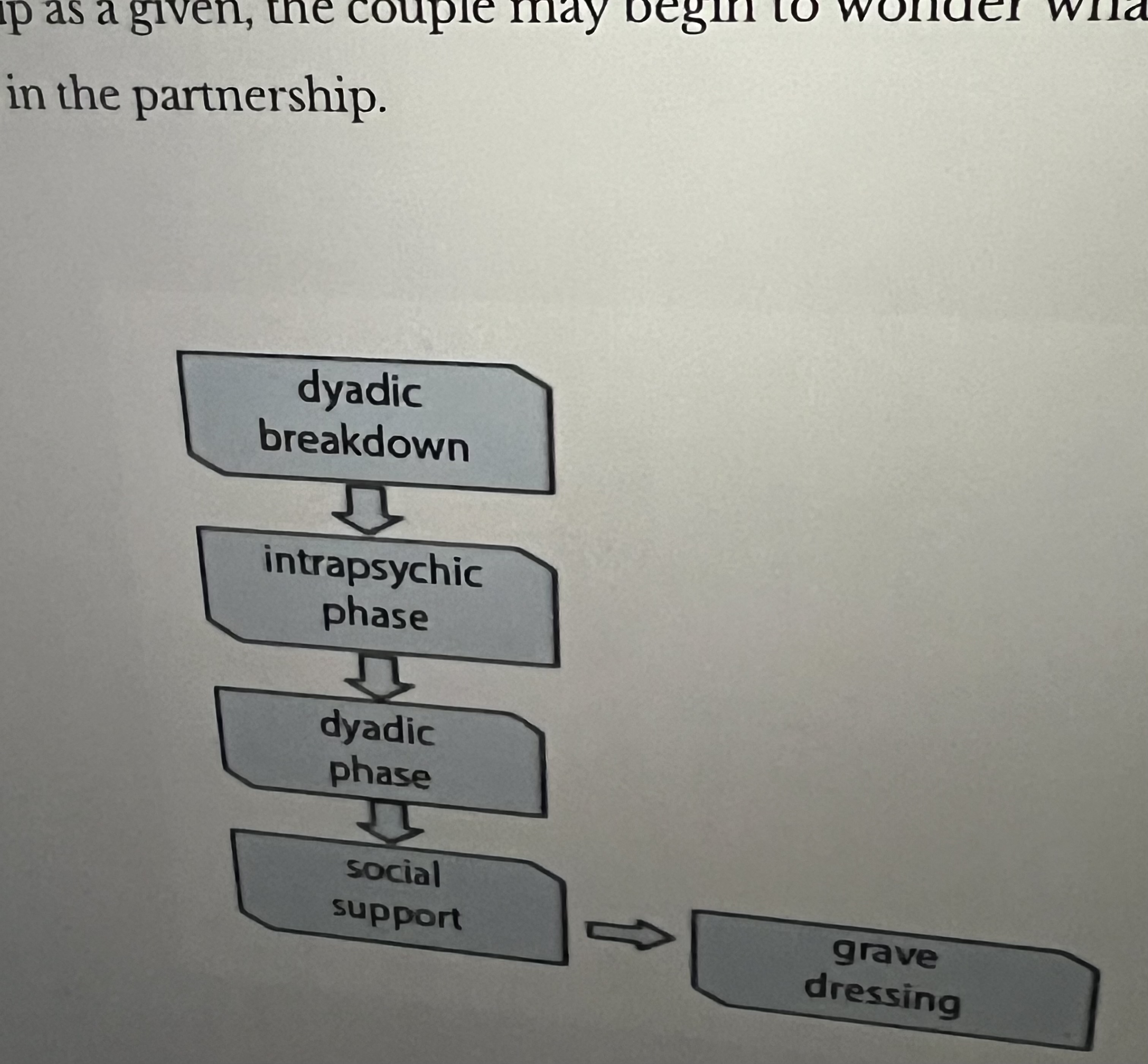
Dyadic Phase
When partners make the choice to talk about their problems. They discuss how to resolve the issues and may seek outside help to help them work through the reasons they are growing apart
Social Support
When termination is inevitable and the partners being to look outside the relationship for social support. Couples will make the need public by telling friends and family
Grave Dressing
When couples reach closure in a relationship and move on with life
Intrapsychic Phase
Occurs when partners worry that they do not connect either one another in ways they used to or that they no longer do fun things together
Egoistic
Selfish Motivations may make us hell
Negative State Relief Model
Suggests that people sometimes help in order to make themselves feel better
Arousal: Cost- reward model
Provides an additional way to understand why people help
5 Factor Model
Each person has each factor, but they occur along a spectrum,
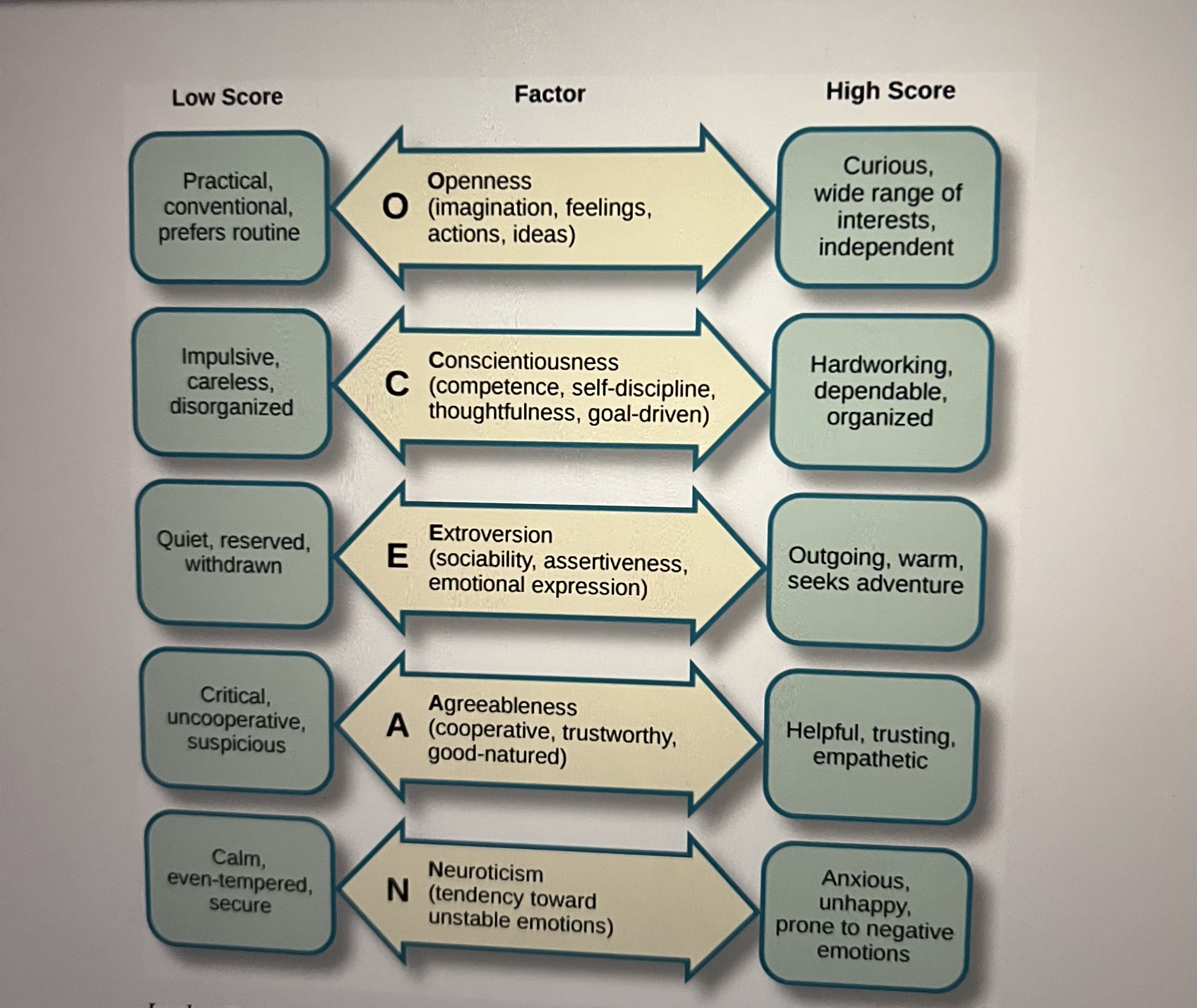
Machiavellianism
Widely used negative term to characterize unscrupulous politicians of the sort Machisvellj described most famously in the The Price
Machiavellianism, named after who?
Niccolò Machiavelli, was an Italian Renaissance his, politician diplomat philosopher
Pro social Moral Reasoning
Reasoning about moral dilemmas in which one person’s needs or desires conflict with those of needy others in a context in which there are few to no rules or formal obligations to prevent the needs
Social Exchange Theory
Posits that all human relationships are formed by the use of a subjective cost-benefit analysis and the comparison of alternatives
Overjustification Effect
When offering an external reward (extrinsic) for an activity can diminish intrinsic motivation for that activity
Intrinsic Motivation
Arising from internal factors that are performed because of these of personal satisfaction
Extrinsic Motivation
Arising from external factors that are performed in order to recurve something from others
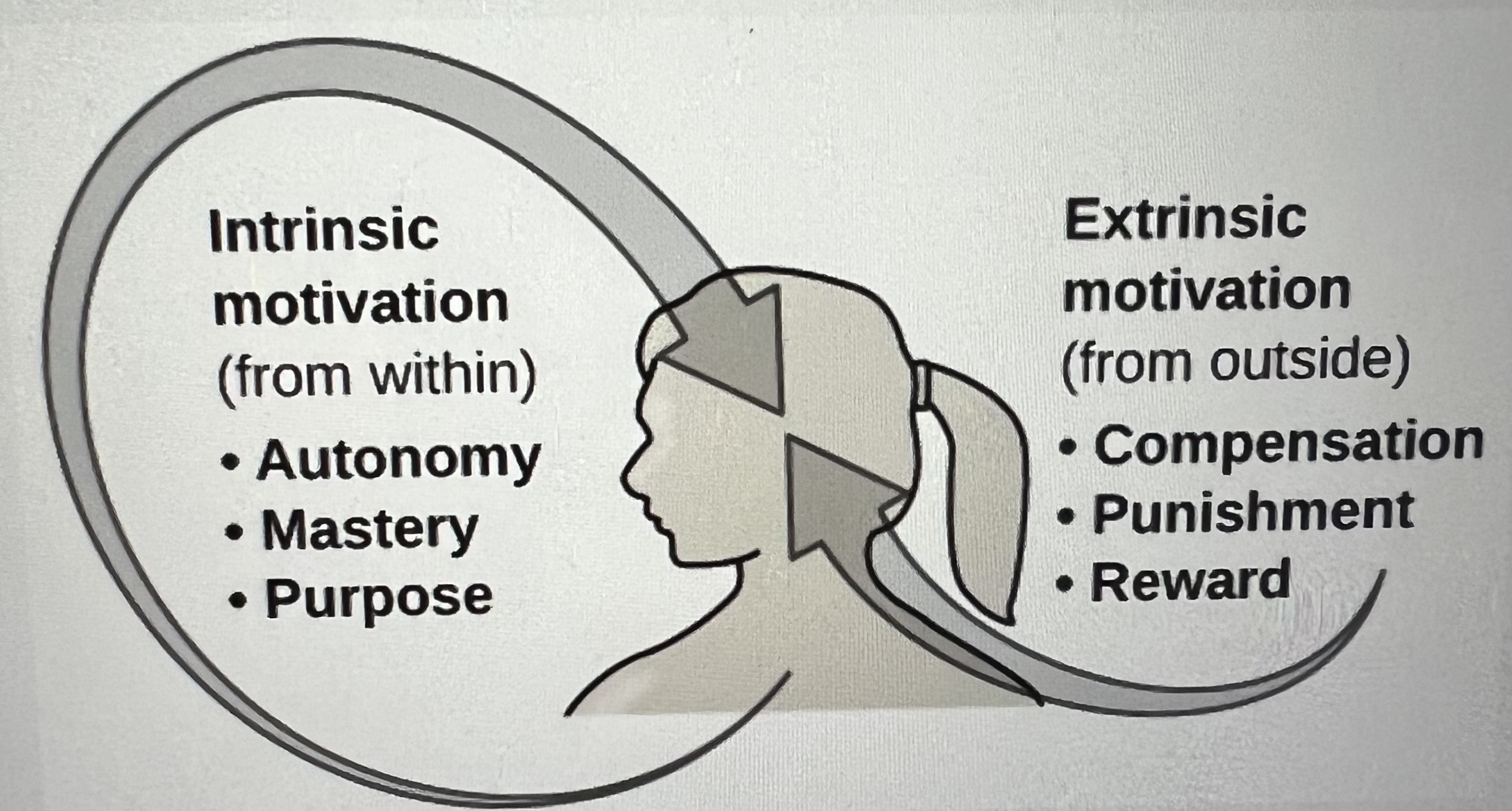
Kin Selection
Favoritism shown for helping our blood relatives
Prosocial Moral Reasoning
About moral dilemmas in which one person’s needs or desires conflict with those of needy others in a context in which there are few to no rules or formal obligations to prevent the needs
Social Responsibility Norm
That tells us that we should try to help others who need assistance even without any expectation of future paybacks
Reciprocal Altruism
Everyone is better off in the long run if we help one another. If helping someone now increases the chances that you will be helped later then your overall chances of survival are increased.
Types of Intrinsic Motivations
Personal Fulfillment: Specifically, “individuals are intrinsically motivated when they seek enjoyment interest, the satisfaction of curiosity, self-expression, or personal challenge in the work”
Religious Expression: Out of moral duty or to benefit society
Over justification Effect
Where the introduction of a reward/incentive can have a negative effect on an individual’s intrinsic motivation to complete a task they were originally motivated to do
The Evolutionary Approach to Attraction
Behaviors, traits and other characteristics are associated with genes (which means they can be passed on to the next generation without learning)
Mate Selection
We prefer mates who increase our likelihood of propagating our genes. Because they increase the likelihood that we have kids with good genes and our kids will be successful at propagating their genes
Attractive Facial Features
Youthful, symmetrical & average faces
Facial Cues Experiment
Based on the picture 2 faces (mixture of faces from a certain place into one), asking participants which one wants a short or long term relationship
Facial Cues Experiment - Results
The men thought the woman with the sharper features (short term) is more attractive
Women found the man with sharper features (long term) more attractive
The Sociocultural Perspective
Women trade beauty for money because they often lack direct access to money → economic power increases desire for beauty
Sex Ratio Effects on Conspicuous Consumption

Do we Know What We Want? - Experiment
Results: Participants stated preferences DID NOT predict their actual choice
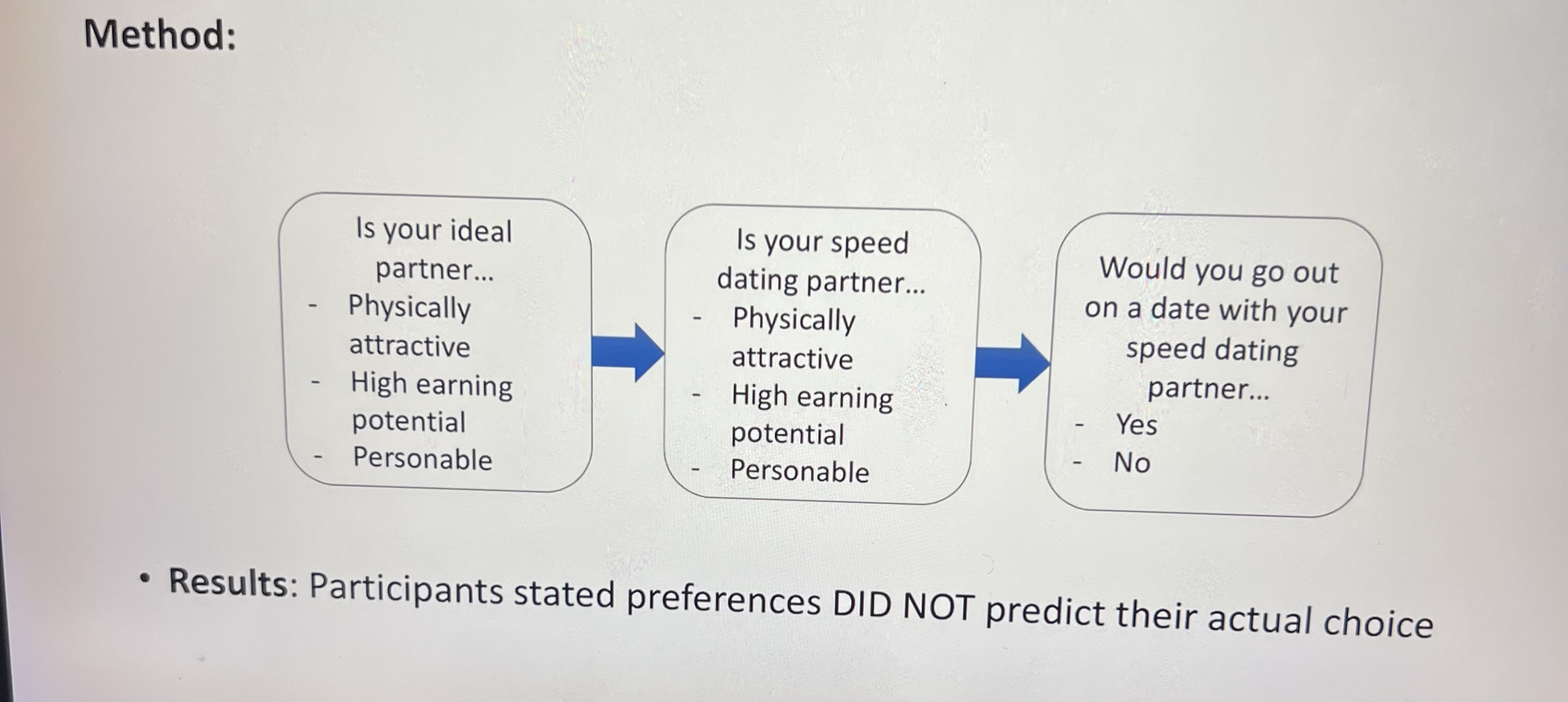
Similarity
Opposites Attract: Do we like those who balance us out?
Matching Principle: Do we like those who are similar to us?
Similarity → Attraction
General Concensus: Particpants report stronger attraction to objectively similar others
Ex. Attitudes (e.g. I like pop music), Personality traits (e.g. extraversion), External qualities (e.g. hairstyle)
Physical Similarity
Physical similar people are liked better and helped more, but people are less sexually attracted to them
Explanation: Liking - kin selection, Sexual attraction - avoid inbreeding
Polyamory (Consensual Non-Monogamy or CNM) Main Findings
People in CNM relationships have positive outcomes compared to people in monogamous and NCNM relationships
Vow for Positive Illusions
“I promise to respect, admire, and appreciate you for who you are, as well as for the person you wish to become
Positive Illusions
Idealizing a romantic partner leads to: more relationship satisfaction, happiness, less fighting m, less decline in marital satisfaction over time
Michelangelo Effect (Positive Illusions)
Partners adapt to each other/sculpt
Vow based on Autonomy
“I promise to support and protect your freedom; because although our lives are intertwined, your choices are still yours alone
Autonomy
A sense of independence and the feeling that we have personal control over our behavior
Altough humans are social creatures, it’s also important to maintain our individuality
Vow based on Responsiveness
“I promise to seek a deep understanding of your wishes, your desires, your fears and your dreams”
Responsiveness
A responsive partner is someone who is good at making you feel understood, validated and cared for
Vow based on Sacrifices
“I promise to always strive to meet your needs; not out of obligation, but because it delights me to see you happy”
Sacrifices
Relationship sacrifices are only related to relationship satisfaction when they are made our of approach (e.g. wanting to see your partner happy) as opposed to avoidance motives (e.g. wanting to avoid conflict)
Vow based on Attachment
“I promise to be there for you when you need me, whenever you need me”